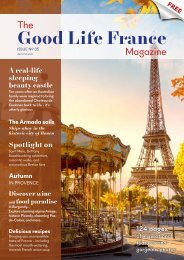Summer 2024
Full of fabulous features, fantastic photos - inspiring, entertaining and informative. Culture and history, destination guides including Paris, Brittany, Toulouse, Troyes, Alsace-Lorraine, Champagne and more. Discover brilliant city, country, seaside and gourmet breaks. Truly scrumptious recipes to make at home. And much, much more. Bringing France to you - wherever you are.
Full of fabulous features, fantastic photos - inspiring, entertaining and informative. Culture and history, destination guides including Paris, Brittany, Toulouse, Troyes, Alsace-Lorraine, Champagne and more. Discover brilliant city, country, seaside and gourmet breaks. Truly scrumptious recipes to make at home. And much, much more. Bringing France to you - wherever you are.
You also want an ePaper? Increase the reach of your titles
YUMPU automatically turns print PDFs into web optimized ePapers that Google loves.
The giants of the north at the town hall<br />
when the town’s lofty belfry was being built.<br />
The 75m high UNESCO-listed belfry, which<br />
took almost 100 years to complete, was voted<br />
France’s favourite monument in 2015. Take a<br />
lift and climb the last few stairs to perch on the<br />
viewing platform and take in superb views over<br />
the town.<br />
Below is the town hall. Destroyed during<br />
World War I, it was rebuilt with a spectacular<br />
Flamboyant Gothic façade, while the interior<br />
features exquisite art deco rooms. The tourist<br />
office is based here, watched over by several<br />
giants, UNESCO-listed larger-than-life<br />
effigies. Made from willow and papier-mâché<br />
these party loving, several-metres-high<br />
puppets, stars of festivals and carnivals, are<br />
the pride and joy of northern France.<br />
Underneath the town hall, and accessible<br />
from the tourist office you’ll find Les Boves,<br />
a labyrinth of underground galleries first dug<br />
out in the 9th Century. These former chalk<br />
quarries were once used for religious services<br />
before becoming storage space for wealthy<br />
merchants, and then barracks for soldiers<br />
during World War 1, a permanent exhibition<br />
tells the story.<br />
Behind the town hall is the Saint-Vaast<br />
Abbey and Museum of Fine Arts (which is<br />
closed until 2030 while it is undergoing<br />
transformative works). And close by, a plaque<br />
marks the house where local boy Maximilien<br />
Robespierre, the “terror” of the French<br />
Revolution, lived from 1787-1798.<br />
A short walk from the city centre, the UNESCO<br />
listed, 17 th century Citadel of Arras was the<br />
first fortress created by Louis XIV’s legendary<br />
military engineer Vauban, at the same time a<br />
second fortress was built in nearby Lille. The<br />
wonderfully preserved fort, which functioned<br />
as a military base until 2010, is essentially<br />
a town within a town and has been given a<br />
new lease of life as a community hub with<br />
residential housing and businesses including<br />
a cheese refinery, treetop adventure centre<br />
and honey farm. It’s also where Main Square,<br />
the famous annual music festival, is held.<br />
Nicknamed the “belle inutile” as it was never<br />
besieged, the Citadel was used as a prison by<br />
the Germans during World War II and there is a<br />
moving memorial garden created by the local<br />
townspeople in honour of the 280 members of<br />
the local Resistance who were executed here.<br />
Remembrance tourism –<br />
bringing history to life<br />
Next to the citadel is the Faubourg<br />
d’Amiens Cemetery, last resting place<br />
of more than 2,500 Commonwealth<br />
servicemen killed in World War I. When<br />
I visited, gardeners were tidying the<br />
cemetery, keeping it in pristine condition as<br />
always. They stopped work and stood stock<br />
still, as did I, when the haunting sounds of a<br />
lone piper carried on the air. The musician<br />
was Philip Astor who was visiting with his<br />
wife and played the bagpipes in honour of<br />
his grandfathers who fought in the. Great<br />
War. We all had tears in our eyes.<br />
The gardeners were from the Commonwealth<br />
War Graves Commission Experience in<br />
Beaurains, just 4km from the centre of<br />
Arras. Visit for a fascinating glimpse into the<br />
Philip Astor<br />
organisation’s painstaking work maintaining<br />
Commonwealth cemeteries, monuments and<br />
memorials around the world.<br />
Forever marked by two world wars, there are<br />
many major remembrance sites in and around<br />
Arras including the Ring of Remembrance on<br />
which are inscribed the 579,606 names of<br />
every soldier who died in the region of Nord-<br />
Pas de Calais in the Great War, whatever their<br />
nationality or rank and regardless of what side<br />
they were on. Vimy Memorial is Canada’s<br />
largest overseas memorial. And Ablain-Saint-<br />
Nazaire French Military Cemetery, also known<br />
as Notre Dame de Lorette, the largest French<br />
military cemetery in the world.<br />
Wellington Quarry, a 10-minute walk from the<br />
town, is a museum and memorial to those who<br />
fought in the battle of Arras. On April 9, 1917,<br />
24,000 British Empire soldiers, billeted in a<br />
warren of underground tunnels, leapt forth in<br />
the most daring surprise attack of the Great<br />
War. It’s an emotional presentation, most<br />
people require tissues at the final stage.<br />
18 | The Good Life France The Good Life France | 19

















